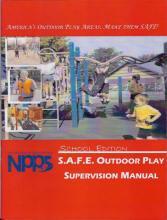
The National Program for Playground Safety (NPPS) was created in October of 1995 to help communities across the nation examine the critical issues surrounding playground safety. S.A.F.E. is an acronym created by NPPS and used in its National Action Plan to help the public create safe play environments for children. The purposes of the National Action Plan and the S.A.F.E. acronym are to provide a blueprint for playground safety.1
The letter “S” represents Supervision. When playing out on the playground, children should always be supervised by adults. Playground supervisors should be trained and provide support and know how to respond to emergencies. NPPS has an educational supervision training kit and on-line training programs for adults who supervise in child care and another for those who supervise in elementary schools.2
The letter “A” represents Age appropriate design. The U.S. Consumer Product Safety Commission (CPSC) and ASTM International (ASTM) recommend that playground equipment should be separated for children ages 6-23 months (toddler), ages 2-5 years (preschool), and ages 5-12 years (elementary school). NPPS encourages the separation to go even farther: pre walkers and walkers for toddlers; ages 2-3 and 4-5 for the preschoolers; and grades K-2, 3-4, and 5-6 for school age. The Americans with Disabilities Act (ADA) also has standards indicating that children with disabilities must be able to get to and from the edges of the playground to equipment and be able to play on some equipment.3
The letter “F” represents Fall surfacing. Appropriate surfacing for children to use and fall on are loose fill materials, such as sand, pea gravel, wood products, and rubber products. Rubber tiles, mats, and similar materials may also be acceptable if they meet the recommendations of the U.S. Consumer Product Safety Commission and ASTM F1292 standard. Fall surfaces for inside playgrounds must also meet that guideline and standard. Asphalt, dirt, concrete, and grass are not acceptable surfaces for under and around playground equipment.4
The letter “E” represents Equipment maintenance. Routine maintenance should be accomplished according to manufacturer’s recommendations and CSPC guidelines. Some routine maintenance suggestions include:
- Check for broken equipment, gaps, and entanglement hazards
- Periodically stain, seal, or paint wooden and metal play structures to prevent deterioration
- Check for missing or damaged components
- Remove debris, litter, feces, glass, pop tops, or rocks from the play area5
- 1. “S.A.F.E.--National Action Plan.” National Program for Playground Safety. < http://www.playgroundsafety.org/safe/index.htm> 3 Feb. 2011.
- 2. “Child Care—S.A.F.E. Tips.” National Program for Playground Safety. < http//:www.playgroundsafety.org/childcare/tips.htm> 3 Feb. 2011.
- 3. Ibid.
- 4. Ibid.
- 5. Ibid.

